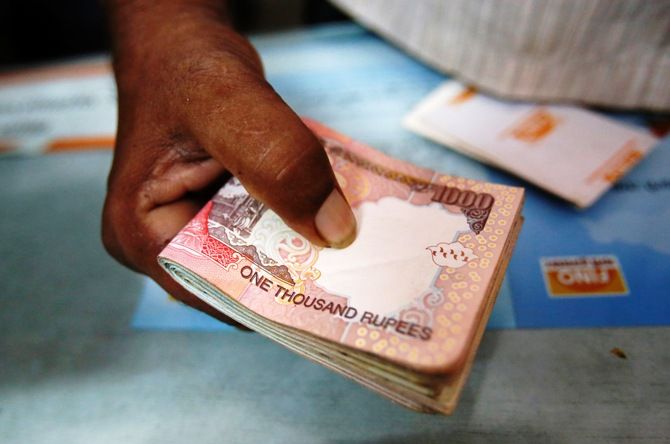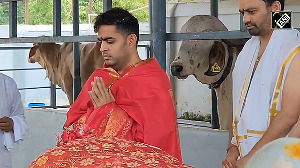 Government will get to use it for infra spending, social-sector schemes, balancing the fiscal
Government will get to use it for infra spending, social-sector schemes, balancing the fiscal
With global crude oil prices, already low for a while, expected to remain below $70 a barrel for the rest of this financial year, besides an expected increase in indirect-tax buoyancy, the Narendra Modi-led central government is looking at a spending cushion of about Rs 1 lakh crore for 2015-16.
The savings, especially those on account of lower subsidies, are likely to be used for infrastructure spending, social-sector schemes, and for balancing the fiscal maths, Business Standard has learnt.
The government’s total budgeted expenditure for 2015-16 is Rs 17.77 lakh crore (Rs 17.77 trillion) -- Rs 15.36 lakh crore (Rs 15.36 trillion) meant for revenue expenditure, and Rs 2.41 lakh crore (Rs 2.41 trillion) for capital spending.
This is the Centre’s highest-ever budgeted capital outlay, against the backdrop of Finance Minister Arun Jaitley’s stated commitment to boosting public spending on infrastructure.
Over the past three years, the finance ministry -- first under P Chidambaram and then under Jaitley -- has had to effect massive government spending cuts to finance high subsidy bills and to meet ambitious fiscal deficit targets.
In no financial year since 2011-12 have the government’s revised expenditure estimates been higher than budgeted estimates.
And, even in that year, that was so because of a rise in revenue spending.
The last time the Centre actually paid more in capital expenditure than budgeted estimates was in 2010-11.
This year, officials are confident there will be be no spending cuts, and the government might in fact have the rare headroom to spend more than budgeted, without worrying about fiscal arithmetic.
“The situation is comfortable this year and we have a lot of fiscal breathing space. We expect savings on the subsidy side, primarily due to (low) oil prices.
"The budgeted spending targets will surely be met. We may even exceed those,” said a senior government official.
On the revenue side, higher buoyancy on indirect taxes is expected to give Jaitley extra spending room.
The Centre collected Rs 1.54 lakh crore (Rs 1.54 trillion) in indirect taxes in April-June this year, up 37 per cent over the Rs 1.12 lakh crore (Rs 1.12 trillion) in the year-ago period.
Among the additional measures that played a role in increasing indirect tax collections were an increase in excise duty on petroleum products between November 2014 and January 2015, the withdrawal of excise duty exemption on auto and other consumer durables, and an increase in service tax from 12.36 per cent to 14 per cent (effective June).
Officials confirmed the extra spending cushion will primarily be used for infrastructure projects at a time when corporate India’s balance sheets are overstretched.
In the Budget for 2015-16, Jaitley had delayed the government’s earlier fiscal consolidation road map by easing the deficit target for 2015-16 to 3.9 per cent of gross domestic product, against 3.6 per cent earlier.
The move freed an additional Rs 70,000 crore (Rs 700 billion) for spending on infrastructure projects.
The Centre’s capital expenditure in the first half of the current financial year is likely to rise a little more than 25 per cent over a year ago, to Rs 1.25 lakh crore (Rs 1.25 trillion), the highest ever for April-September in any year.
The infrastructure and energy ministries have been told to spend most of their capital expenditure in the first six months of the year, with a promise they will be provided more under the supplementary demand for grants in the winter session of Parliament, if need be.
The remaining of the extra spending room, about Rs 30,000 crore (Rs 300 billion), will be used for social-sector schemes and for balancing the fiscal maths, in case the Centre spends above the budgeted estimate.
Sources admit the social-sector and poverty-alleviation schemes figure lower on the priority list this year, as the onus is primarily on state governments.
The government has this year cut its spending on sectors like health and education.
This has been due to a 10 per cent increase in devolution to states from the Centre’s tax resources, according to the recommendations of the 14th Finance Commission.
According to Jaitley’s statement in the budget session, an increase in devolution to states will get Rs 1.86 lakh crore (Rs 1.86 trillion) more from the divisible pool.
The government also delinked eight centrally sponsored schemes from central support, and partially delinked 24 that would be run with shared central and state funding.
Some of the schemes fully or partially delinked include Backward Regions Grant Fund, Rashtriya Krishi Vikas Yojana, National Livestock Mission, Swachh Bharat, National Health Mission and Madhyamik and Uchcha Siksha Abhiyaan.
Oil prices have been comfortably below the $70-a-barrel level at which the Budget for this year was prepared.
On Wednesday, West Texas Intermediate was trading $50.04 a barrel, while Brent Crude was trading at $56 a barrel.
Low oil prices might lead to Rs 30,000-35,000 crore (Rs 300-350 billion) of savings in April-June on account of combined major subsidies.
The outgo for major subsidies like those on fuel, food and fertiliser are traditionally the highest for a year in the April-June quarter, as it includes pending payments and outlays for carried-over subsidy demands.
The total combined major subsidies for the first two months of the current year were around Rs 49,557 crore (Rs 495.57 billion).
That is 30 per cent less than the Rs 71,250 crore (Rs 712.5 billion) in major subsidy outlays for April and May of 2014-15.
Officials also say that with regard to food subsidy, streamlining procurement and distribution operations, and a planned rollout of direct cash transfers for foodgrain beyond the Union territories could lead to a savings of Rs 4,000-5,000 crore (Rs 40-50 billion).
Major budgeted subsidies for the year total about Rs 2.27 lakh crore (Rs 2.27 trillion) -- Rs 72,968 crore (Rs 729.68 billion) for fertiliser subsidy, Rs 30,000 crore (Rs 300 billion) for fuel subsidies, and about Rs 1.24 lakh crore (Rs 1.24 trillion) for food subsidies.












 © 2025
© 2025